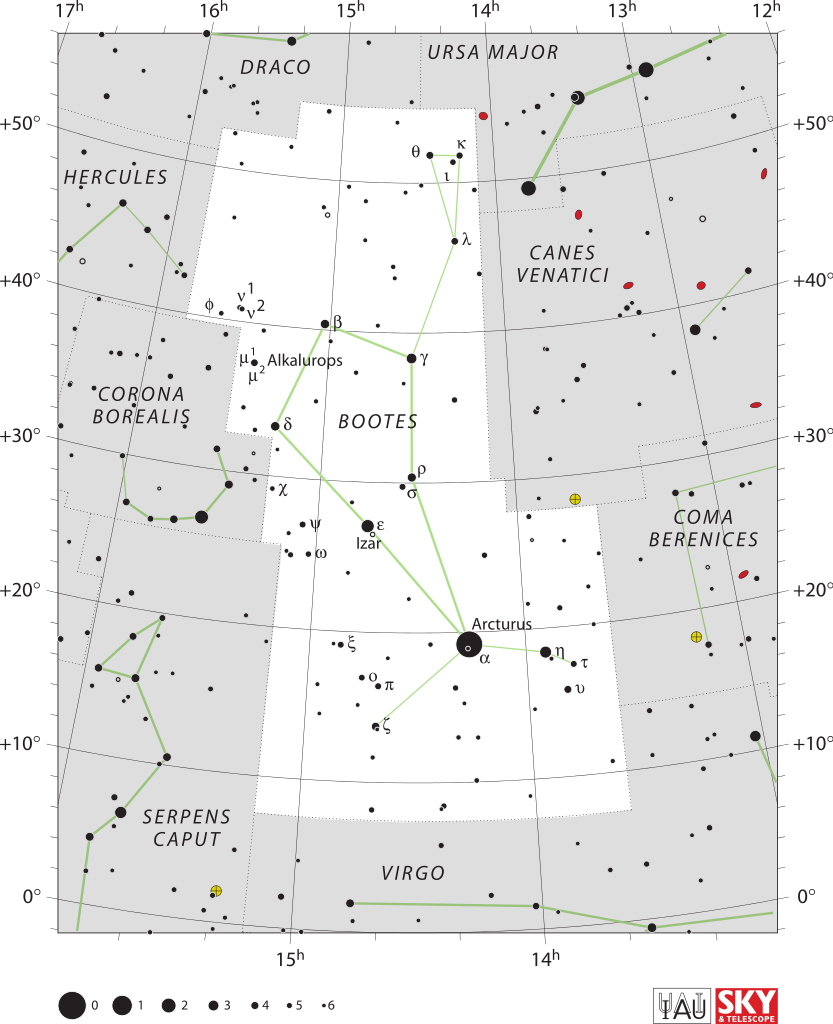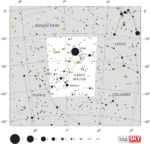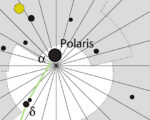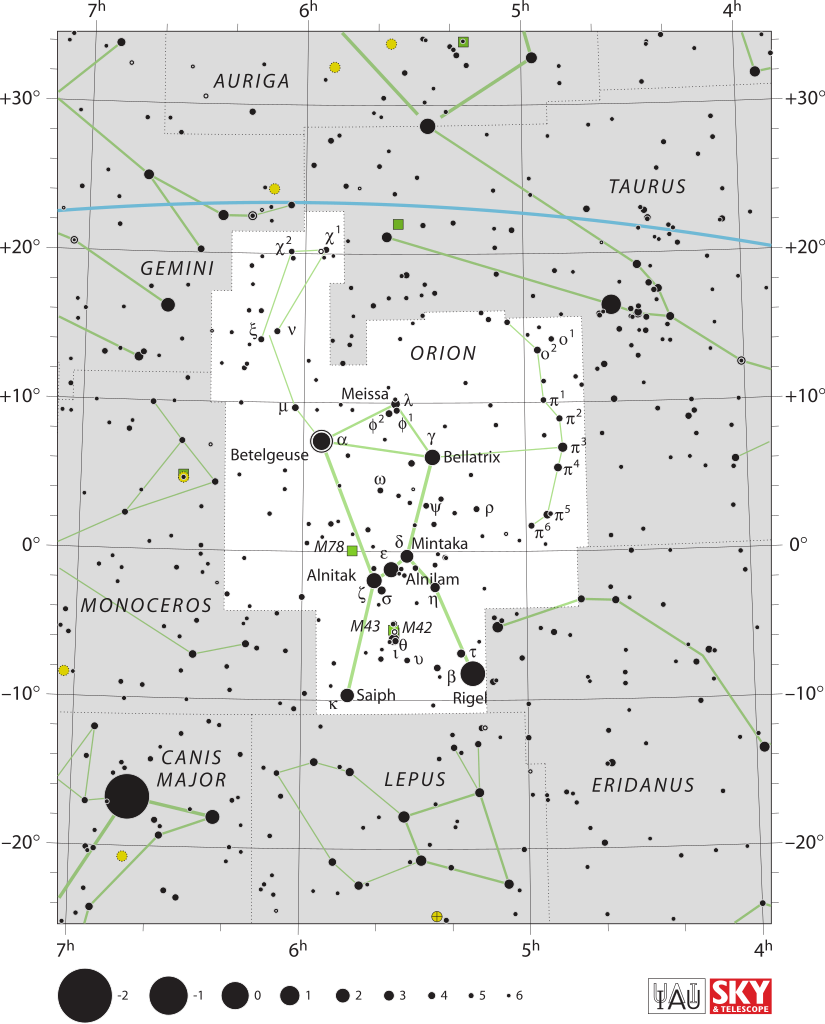November is the third month of Cygnus Term, our fall term in the River Houses, and as our monthly star calendar will tell you, November’s Great Star is Algol, “the Demon Star,” the second-brightest star in the constellation Perseus the Hero. Its formal designation is β Persei — “beta of Perseus.” Perseus and Algol are high in the east in the evening now, passing right overhead about midnight.
![[Perseus and Algol]](https://riverhouses.org/wp-content/uploads/2022/11/perseus-iau-chart.png)
If you want to introduce your students to Algol and Perseus you can start with some basic astronomy and astronomical mythology from your backyard star guide:
Visible for much of the year in the northern sky, Perseus straddles the Milky Way between Cassiopeia and Andromeda, characters from the same Greek myth in which he takes center stage as the story’s hero. This constellation is relatively easy to pick out for a beginning stargazer. Although visible for much of the year, the best times to view Perseus are in the late fall months.
With magnitude 1.8 Mirfak at its center, and five other stars of magnitude 3 or greater, Perseus contains bright and notable signposts. Among them is Algol (Beta Persei), a well-known eclipsing variable that dims by a full magnitude for about 10 hours every three days. [The mythological Perseus,] the half-mortal son of Zeus, is one of the more prominent Greco-Roman heroes. A favorite of Athena, he received many gifts from her, including a polished shield. In going into battle with the Gorgon Medusa — who, with one look, could turn any human or animal into stone — Perseus used the shield as a mirror to avoid her direct gaze. When he lopped off her head, the winged horse Pegasus was born of her blood and Perseus took it for his own. In his second great feat, Perseus used Medusa’s head as a weapon to help him rescue Andromeda from the sea monster Cetus: even severed from her body, the Gorgon’s stare turned Cetus to stone. (Backyard Guide to the Night Sky, pages 244–245)
That’s plenty for beginning students — your little lesson is done. If you want to get more advanced, the Wikipedia page on Algol is packed with additional information on everything from astrometry to cultural history.
![[Algol]](https://upload.wikimedia.org/wikipedia/commons/8/86/Algol_triple_star_system_imaged_with_the_CHARA_interferometer.jpg)
The Algol we see is actually a complex three-star system (Algol A, B, and C). Algol A and B orbit each other at just the right angle from our perspective on earth such that they pass in front of each other every few days, causing the apparent brightness of “Algol” to vary. The Algol A–B pair is thus referred to as an eclipsing binary: when you see it dim, you are watching the actual crossing of these two orbiting stars 93 light-years away (practically next door in astronomical terms).
Here’s a classic seven-minute educational film about Algol that shows how an eclipsing binary system works and how astronomers can determine its structure. Open it up on a large screen for your students to watch.
The name Algol comes from the Arabic al-ghūl meaning “the ghoul” or “the demon,” and from this we get Algol’s colloquial name “the Demon Star” — the demon in question being Medusa the Gorgon whose decapitated head, marked by Algol, is being carried by Perseus. Astronomy and mathematics are two areas that have borrowed quite a few words from Arabic, often by way of medieval Latin. You can spot many of these words because they often begin with al-, the definite article (“the”) in Arabic: Al-debaran, Al-pheratz, Al-gol, Al-gebra, Al-gorithm, and more.
![[Urania's Mirror (1824)]](https://upload.wikimedia.org/wikipedia/commons/thumb/9/9c/Sidney_Hall_-_Urania%27s_Mirror_-_Perseus.jpg/1024px-Sidney_Hall_-_Urania%27s_Mirror_-_Perseus.jpg)
Sometime this month, take your homeschool students out at dusk and introduce them to this strange system of suns, and teach them its name, and so give them a new friend for life.
What astronomical observations and stellar sightings have you and your students made in your homeschool this Cygnus Term? 😊
❡ Alpha and beta and gamma, oh my: Most of the principal stars within each constellation have both old vernacular names — Vega, Sirius, Arcturus, and so on — as well as more formal scientific designations. The German astronomer Johann Bayer (1572–1625) devised the formal system of star designations that is still in common use today. In Bayer’s system, the stars in each constellation, from brightest to dimmest, are assigned a lowercase letter of the Greek alphabet: α (alpha, brightest), β (beta, second brightest), γ (gamma, third brightest), δ (delta, fourth brightest), and so on. This letter designation is combined with the name of the constellation in its Latin possessive (genitive) form: Lyra becomes Lyrae (“of Lyra”), Canis Major becomes Canis Majoris (“of Canis Major”), and so on. The brightest star in the constellation Lyra (the star Vega) thus becomes α Lyrae (“alpha of Lyra”), the brightest star in Canis Major (the star Sirius) becomes α Canis Majoris (“alpha of Canis Major”), and so on, through all 24 Greek letters and all 88 constellations. How bright would you expect, say, the σ (sigma) star of Orion to be? Not very bright — it’s far down the alphabet — but σ Orionis happens to mark the top of Orion’s sword, so even though it’s not very bright it’s still notable and easy to locate on a dark night. ✨
❡ Star bright: The brightness of a star as we see it in our night sky is its magnitude — or more properly, its apparent magnitude. The scale of star magnitudes was developed long before modern measuring instruments were invented, so it can be a little bit confusing for beginners. Originally, the brightest stars in the sky were called “first magnitude” and the less-bright stars “second magnitude,” “third magnitude,” and so on, down to the dimmest stars visible to the naked eye, which were called “sixth magnitude.” In the nineteenth century the star Vega (our August star) was chosen as the standard brightness reference and its value on the magnitude scale was defined to be zero (0.0). Five steps in magnitude (from 0.0 to 5.0 or from 1.0 to 6.0) was defined to be a change in brightness of 100 times: a star 100 times dimmer than Vega (0.0) was defined to be a magnitude 5.0 star. Vega is not quite the brightest star is the sky, however, so the scale also had to be extended into negative numbers: Sirius (our March star), for example, is magnitude –1.5, about three times brighter than Vega (at 0.0). The planet Venus at its brightest is about magnitude –4.2; the full moon is about magnitude –12.9; the sun is magnitude –26.7. By contrast, the dimmest stars visible to the naked eye in a populated, light-polluted area are about magnitude 3.0; the dimmest stars visible under very dark conditions are about magnitude 6.5. The Hubble Space Telescope in orbit around the earth has photographed distant stars and galaxies below magnitude 30, the dimmest celestial objects humans have "seen" so far. 🌃
❡ And all dishevelled wandering stars: How far away are the stars? To answer that question we have to begin with one of the most basic phenomena of astronomy: the distinction between the planets (“wanderers”) and the fixed stars. The fixed stars form the constellations, and they all move in concert, rotating through the sky every night around the celestial pole. The planets, by contrast, move among the fixed stars week by week, following a regular narrow track called the ecliptic. The Big Dipper is always the Big Dipper, but Jupiter will be in one constellation this month, and then another next month, and then another the month after that. (The constellations that the planets pass through along the ecliptic comprise the zodiac.) The wandering planets seem obviously nearer to us than the fixed stars and they move at different speeds, but are the fixed stars themselves all the same distance away? Do they all occupy a single celestial “dome” that rotates through the heavens (as some ancient and medieval astronomers believed), or are they scattered through space at different individual distances? Astronomers had long suspected that the fixed stars existed at different distances from us, but early attempts to measure those distances failed. It was not until the early 1800s that instruments and measuring techniques became precise enough to allow the first stellar distances to be calculated through the study of parallax. Parallax is the displacement in the apparent position of an object with respect to the background when an observer moves from side to side. It’s an ordinary phenomenon you experience every day — it’s how we judge distances as we move through the landscape. Stellar parallaxes are extremely small — fractions of an arc-second (one 3600th of a degree) — and they are calculated by measuring a star’s position against the background at opposite sides of the earth’s orbit, six months apart. (That’s the astronomical equivalent of taking one step to the side.) Vega, our August star, was one of the first stars to have its parallax measured; modern estimates put it at about 0.13 arc-seconds. Apply some trigonometry, and that yields a distance of about 25 light-years. 🔭
❡ Watchers of the skies: Teaching your homeschool students to recognize the constellations is one of the simplest and most enduring gifts you can give them. We recommend the handy Backyard Guide to the Night Sky as a general family reference — it will help you identify all the northern hemisphere constellations and will point out many highlights, including the names and characteristics of the brightest stars. Your recommended world atlas also has beautiful maps of the whole northern and southern hemisphere night skies on plates 121–122 (10th and 11th eds.). Why not find a dark-sky spot near you this month and spend some quality homeschool time beneath the starry vault. 🌌
❡ Hitch your wagon to a star: This is one of our regular Homeschool Astronomy posts featuring twelve of the most notable stars of the northern hemisphere night sky. Download and print your own copy of our River Houses Star Calendar and follow along with us as we visit a different Great Star each month — and make each one of them a homeschool friend for life. 🌟
❡ Print this little lesson: Down at the bottom of this post you’ll find a special “Print” button that will let you create a neat and easy-to-read copy of this little lesson, and it will even let you edit and delete sections you don't want or need (such as individual images or footnotes). Give it a try today! 🖨
❡ Homeschool calendars: We have a whole collection of free, printable, educational homeschool calendars and planners available on our main River Houses calendar page. They will help you create a light and easy structure for your homeschool year. Give them a try today! 🗓
❡ Support our work: If you enjoy our educational materials, please support us by starting your regular Amazon shopping from our very own homeschool teaching supplies page. When you click through from our page, any purchase you make earns us a small commission at no extra cost to you. Thank you for helping us to keep going and growing! 🛒
❡ Join us! The aim of the River Houses project is to create a network of friendly local homeschool support groups — local chapters that we call “Houses.” Our first at-large chapter, Headwaters House, is now forming and is open to homeschoolers everywhere. Find out how to become one of our founding members on the Headwaters House membership page. 🏡




